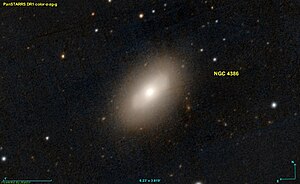NGC 4386
| Galaxy NGC 4386 |
|
|---|---|

|
|
| AladinLite | |
| Constellation | Dragon |
|
Position equinox : J2000.0 , epoch : J2000.0 |
|
| Right ascension | 12 h 24 m 28.35 s |
| declination | + 75 ° 31 ′ 44.1 ″ |
| Appearance | |
| Morphological type | SAB0 ^ 0 ^ |
| Brightness (visual) | 11.7 mag |
| Brightness (B-band) | 12.7 mag |
| Angular expansion | 2 ′, 5 × 1 ′, 3 |
| Position angle | 135 ° |
| Surface brightness | 12.8 mag / arcmin² |
| Physical data | |
| Affiliation |
NGC 4291 group NGC 4386 group NGC 4589 group LGG 284 |
| Redshift | 0.005594 ± 0.000090 |
| Radial velocity | (1677 ± 27) km / s |
|
Stroke distance v rad / H 0 |
(81 ± 6) · 10 6 ly (24.9 ± 1.8) Mpc |
| history | |
| discovery | Wilhelm Herschel |
| Discovery date | December 10, 1797 |
| Catalog names | |
| NGC 4386 • UGC 7491 • PGC 40378 • CGCG 352-033 • MCG + 13-09-027 • 2MASX J12242831 + 7531440 • GC 2948 • H I 277 • h 1247 • LDCE 902 NED006 | |
NGC 4386 is a lenticular galaxy of the Hubble type SB0 in the constellation Dragon in the northern sky . It is estimated to be 81 million light years from the Milky Way and about 55,000 light years in diameter. It is a member of the eleven galaxies NGC 4589 group ( LGG 284 ).
In the same area of the sky are the galaxies NGC 4319 , NGC 4331 , NGC 4363 .
The Type Ia supernova SN 2014bv was observed here.
The object was discovered on December 10, 1797 by the astronomer Wilhelm Herschel .
